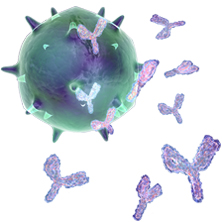Sieniawska E, Michel P, Mroczek T, Granica S, Skalicka-woźniak K Food and Chemical Toxicology, 2019 ABSTRACT: Nigella damascena L belongs to Ranunculaceae family and is mentioned in Eastern traditional medicine for the treatment of high temperatures, regulation of menstruation or catarrhal affections. The anti-inflammatory activity of compounds present in the essential oil obtained from seeds… Read more »

This system includes the lymph nodes, white blood cells, lymphatic vessels, thymus gland, bone marrow, spleen and leukocytes. Common disorders include anything with bacterial, viral or fungal origins, leukemia, allergic reactions and autoimmune diseases like lupus or rheumatoid arthritis.
Effectiveness of topical administration of Anethum graveolens essential oil on MRSA-infected wounds
Manzuoerh R, Farahpour MR, Oryan A, Sonboli A Biomedicine and Pharmacotherapy, 2019 ABSTRACT: Medicinal plants are conventionally used for wound healing, but their action mechanisms are still unknown. The present study evaluated the effect of topical administration of ointment containing dill (Anethum graveolens) essential oil (DEO) in the management of apoptosis and cell proliferation during… Read more »
Evaluation of the possible use of genus Mentha derived essential oils in the prevention of SENLAT syndrome caused by Rickettsia slovaca
Štefanidesová K, Špitalská E, Csicsay F, Friedländerová V, Šáner A, Škultéty Ľ Journal of Ethnopharmacology, 2018 ABSTRACT: ETHNOPHARMACOLOGICAL RELEVANCE: Essential oils and essential oil bearing medicinal and culinary plants have a long tradition of being used to combat infection, treat various conditions, and promote and restore health. Mint oils are traditionally applied to repel insects… Read more »
Coriander essential oil and linalool – interactions with antibiotics against Gram-positive and Gram-negative bacteria
Aelenei P, Rimbu CM, Guguianu E, Dimitriu G, Aprotosoaie AC, Brebu M, Horhogea CE, Miron A Letters in Applied Microbiology, 2019 ABSTRACT: The aim of this study was to evaluate the antibacterial activity of coriander essential oil and its major constituent, linalool, in combination with antibiotics against Gram-positive (methicillin-susceptible and methicillin-resistant Staphylococcus aureus, S. epidermidis) and Gram-negative bacteria… Read more »
Immunotoxicological Evaluation of Schinus molle L. (Anacardiaceae) Essential Oil in Lymphocytes and Macrophages
Duarte JA, Zambrano LAB, Quintana LD, Rocha MB, Schmitt EG, Boligon AA, Anraku de Campos MM, de Oliveira LFS, Machado MM Evidence Based Complementary and Alternative Medicine, 2018 ABSTRACT: Schinus molle L. is used to treat various diseases; however, the literature lacks information regarding its possible immunotoxic effects. The aim of the study was to… Read more »
Antimicrobial Survey of Local Herbal Drugs against Isolated from Patients Admitted to a Level-I Trauma Center
de Macêdo DG, Souza MMA, Morais-Braga MFB, Coutinho HDM, Dos Santos ATL, da Cruz RP, da Costa JGM, Rodrigues FFG, Quintans-Junior LJ, da Silva Almeida JRG, de Menezes IRA Bulletin of Emergency and Trauma, 2018 ABSTRACT: OBJECTIVE: To determine the antimicrobial activity and entity of several local herbal plants against Acintobacters isolated from trauma patients admitted to… Read more »
Effect of Essential Oils from Ginger (Zingiber officinale) and Turmeric (Curcuma longa) Rhizomes on Some Inflammatory Biomarkers in Cadmium Induced Neurotoxicity in Rats
Akinyemi AJ, Adeniyi PA Journal of Toxicology, 2018 ABSTRACT: Studies have revealed that anti-inflammatory agents could provide beneficial effect in lowering the incidence/progression of neurological diseases. Hence, this study sought to investigate the effect of essential oils from Nigeria ginger and turmeric rhizomes on some cytokines in cadmium induced neurotoxicity. The result revealed that essential… Read more »
Effects of a massage-like essential oil application procedure using Copaiba and Deep Blue oils in individuals with hand arthritis
Bahr T, Allred K, Martinez D, Rodriguez D, Winterton P Complimentary Therapies in Clinical Practice, 2018 ABSTRACT: BACKGROUND AND PURPOSE: Existing research suggests that both massage and essential oils may have analgesic and anti-inflammatory benefits. We investigate the benefits of the AromaTouch Hand Technique® (ATHT), a procedure that combines a moderate pressure touch with the application… Read more »
Chromobacterium violaceum and Pseudomonas aeruginosa PAO1: Models for Evaluating Anti-Quorum Sensing Activity of Essential Oil and Its Main Component Terpinen-4-ol
Noumi E, Merghni A, M Alreshidi M, Haddad O, Akmadar G, De Martino L, Mastouri M, Ceylan O, Snoussi M, Al-Sieni A, De Feo V Molecules, 2018 ABSTRACT: The problem of antibiotic resistance among pathogens encourages searching for novel active molecules. The aim of the research was to assay the anti-quorum sensing (anti-QS) and antibiofilm… Read more »
Rosmarinus officinalis essential oil: A review of its phytochemistry, anti-inflammatory activity, and mechanisms of action involved
Borges RS, Ortiz BLS, Pereira ACM, Keita H, Carvalho JCT Journal of Ethnopharmacology, 2018 ABSTRACT: ETHNOPHARMACOLOGICAL RELEVANCE: Plant species Rosmarinus officinalis L. (Lamiaceae; Synonyms: Salvia rosmarinus Schleid. and Rosmarinus angustifolius Mill.) is a herb widely used worldwide. In local and traditional medicine, its used for inflammation-related diseases. Currently, studies report anti-inflammatory activity in its essential… Read more »
